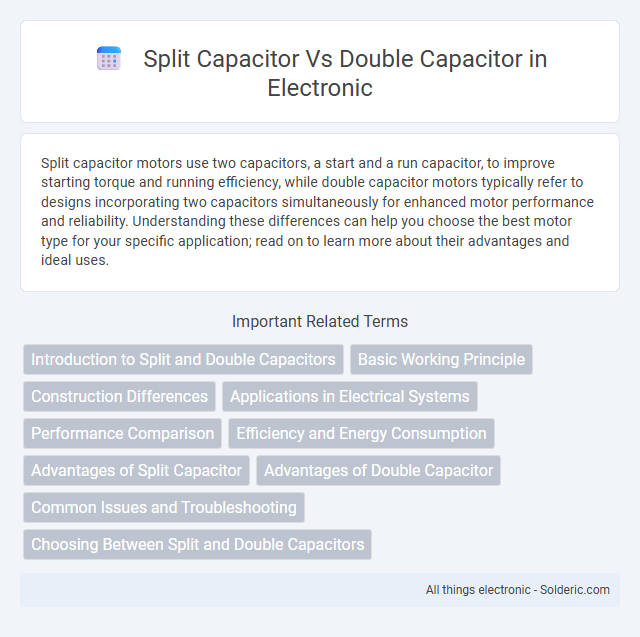Split capacitor motors use two capacitors, a start and a run capacitor, to improve starting torque and running efficiency, while double capacitor motors typically refer to designs incorporating two capacitors simultaneously for enhanced motor performance and reliability. Understanding these differences can help you choose the best motor type for your specific application; read on to learn more about their advantages and ideal uses.
Comparison Table
| Feature | Split Capacitor Motor | Double Capacitor Motor |
|---|---|---|
| Capacitor Configuration | One capacitor divided into two sections | Two separate capacitors (start and run) |
| Number of Capacitors | Single capacitor with split windings | Two capacitors (start & run) |
| Starting Torque | Moderate starting torque | Higher starting torque |
| Run Efficiency | Good running efficiency | Enhanced running efficiency |
| Cost | Lower cost due to fewer components | Higher cost due to additional capacitor |
| Application | Small loads with moderate start requirements | Heavy loads requiring strong start and continuous operation |
| Motor Life | Standard lifespan | Potentially longer lifespan due to reduced stress |
| Complexity | Simpler design | More complex wiring and control |
Introduction to Split and Double Capacitors
Split capacitors consist of two capacitive sections housed within a single casing, designed to provide phase shift for single-phase motor starting and running. Double capacitors, also known as dual capacitors, integrate both the start capacitor and the run capacitor into one unit, optimizing space and simplifying wiring in HVAC systems. These capacitor types differ in construction and application, with split capacitors focusing on phase splitting in motors, while double capacitors address dual functions in compact motor circuits.
Basic Working Principle
A split capacitor motor uses a single auxiliary winding with a capacitor connected in series to create a phase shift, enabling the motor to start and run efficiently. In contrast, a double capacitor motor incorporates two capacitors--one starting capacitor and one running capacitor--connected to separate auxiliary windings, optimizing starting torque and improving running performance. The key difference lies in the double capacitor motor's ability to maintain phase shift for both start and run conditions, enhancing overall motor efficiency.
Construction Differences
Split capacitors consist of two capacitors housed within a single casing, each optimized for different motor functions like start and run. Double capacitors combine two separate capacitors into one unit but maintain distinct individual casing within the assembly for added durability and efficiency. The construction differences impact both application flexibility and performance in electric motor operations.
Applications in Electrical Systems
Split capacitor motors are commonly used in applications requiring moderate starting torque such as fans, blowers, and small pumps, providing efficient performance with lower cost. Double capacitor motors, featuring both start and run capacitors, are ideal for heavy-duty applications like air compressors, refrigeration units, and large HVAC systems where higher starting torque and improved running efficiency are essential. Choosing the right capacitor setup enhances your system's reliability and operational efficiency significantly.
Performance Comparison
Split capacitors offer improved starting torque and smoother operation in single-phase motors by dividing the starting and running windings, whereas double capacitors combine a start capacitor and a run capacitor for enhanced efficiency and power factor correction. Double capacitor systems typically provide better motor performance, higher starting torque, and increased energy efficiency compared to split capacitor designs. Performance metrics such as starting current reduction, operational stability, and energy consumption are significantly optimized in double capacitor applications, making them preferable for high-demand motor operations.
Efficiency and Energy Consumption
Split capacitor motors generally offer moderate efficiency due to their simpler design, which leads to lower initial energy consumption but less optimal performance under varying loads. Double capacitor motors incorporate both start and run capacitors, significantly enhancing motor efficiency by maintaining smoother operation and reducing energy losses during startup and running phases. This results in improved energy consumption management, making double capacitor motors more suitable for applications requiring consistent, efficient performance.
Advantages of Split Capacitor
Split capacitors provide improved motor starting torque and enhanced efficiency by using two capacitors to optimize phase shifting in single-phase motors. They reduce noise and prolong motor life by balancing current flow more effectively compared to double capacitor designs. This leads to better performance in electric motors found in HVAC systems and compressors.
Advantages of Double Capacitor
Double capacitors offer enhanced energy storage and improved voltage stability compared to split capacitors, making them ideal for applications requiring higher reliability and performance. They provide better load handling and reduced electrical noise, which ensures smoother operation in motors and HVAC systems. Your equipment benefits from increased efficiency and longer lifespan due to the superior balancing properties of double capacitors.
Common Issues and Troubleshooting
Split capacitor motors often encounter issues such as capacitor failure, which leads to weak starting torque or humming without motor rotation. Double capacitor motors may face problems with either the start or run capacitor, causing overheating or motor stalling during operation. Understanding the specific capacitor type in your motor simplifies troubleshooting and ensures targeted replacement for reliable performance.
Choosing Between Split and Double Capacitors
Choosing between split capacitors and double capacitors depends on the specific application requirements and design constraints of electric motors or HVAC systems. Split capacitors typically offer a cost-effective solution for single-phase motors by providing starting and running functions in a single unit, while double capacitors provide enhanced performance and reliability by combining separate start and run capacitors, ideal for larger motors needing improved efficiency. Evaluating factors such as motor size, load characteristics, and energy consumption helps determine whether a split capacitor's simplicity or a double capacitor's dedicated functions better suit the operational demands.
Split capacitor vs double capacitor Infographic

 solderic.com
solderic.com